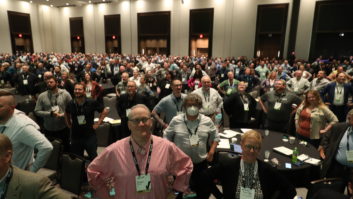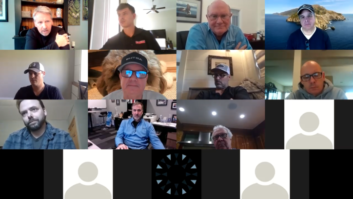New technology has always been the lifeblood of the consumer electronics, computer and communications industries, and recently has emerged as an important factor in the major appliance business.
During the past couple of years, all four industries have experienced a whirlwind of new formats for existing product types, new product types altogether; and convergence products of all stripes – most coming under the digital banner.
For those of you who have been around for more than a few years, it has been difficult to catch up. But for anyone just entering the business, all of the products, the formats and the nomenclature must be mind-boggling, starting with widescreen HDTVs and refrigerators with Internet access, and moving to handheld products such as cellular phones that can browse the web.
This is why we have dedicated most of this issue to a special report, New Technology: A TWICE Primer. In each product section of this issue you will get an overview of the new categories affecting each business, plus a glossary of terms you, your suppliers and your customers need to know.
While TWICE hopes this report will be a helpful overview, it is not meant to replace training.
A discussion of retail training in these industries is kind of like talking about the weather – much has been said, but little is done. However, with the multitude of new technologies entering the business, retailers and manufacturers realize they can no longer afford to be blasé about the subject.
That’s what we heard from several key retail executives when we picked up the phone to discuss the subject. To our surprise, all of them have recently reviewed their training procedures, and all of them agree that retailers cannot automatically rely on manufacturers to do it for them.
“I don’t think that vendors should be 100% responsible for training,” said Ray Navarrete, senior VP of merchandising for New York-based RCS Computer Experience. “If you want to be a leading-edge retailer you have to train your people so they can educate the public.”
Training is “the difference between good and great sales, and good and great profit,” Navarrete said, emphasizing that training is also a “shared responsibility between retailers and vendors. Retailers should have a plan and negotiate what role they want vendors to take.”
Bill Trawick, VP of Conn’s, said that during the past 60 to 90 days his company has been working on a plan for training salespeople about new technology. “Are we prepared? That’s what we’ve asked ourselves,” Trawick said. “We hired a member of the Houston school system who has prepared a curriculum and written booklets on HDTV, DVD and other categories.”
Those at Conn’s who want to sell new technologies must take classes and learn the curriculum, Trawick said. “They are then tested in front of a panel of executives. Role-play is used, and if they pass, they are certified to sell the category. If not, they can’t sell the category, but they can be re-tested.”
Trawick said Conn’s decided to develop its own program because, “from what we are seeing, there have been [vendor] cutbacks in training versus years ago by some, while others will help.”
Con Maloney, CEO of Cowboy Maloney’s Electric City, said that during the past couple of years the product release cycle has put more pressure on retailers: “Product is released to consumers so quickly now that you can’t have the intensive training you’ve had in the past. Cutting-edge consumers can buy the product before we know what we are selling!”
The chain’s VP Johnny Maloney, whose responsibilities include training, said that Cowboy Maloney’s has intensified its training efforts: “During the past six years, every October, we hold Camp Cowboy in preparation for the Christmas selling season. We bring everyone into a hotel and hold a day’s worth of sessions. Our people meet with 10 vendors who give us the ‘bullets’ to sell product.”
In addition, Cowboy Maloney’s does local training at its stores, especially when it runs local promotions. “For instance,” said Maloney, “we just celebrated the fifth anniversary of the introduction of DirecTv. We were fortunate to be the first dealer in the U.S. to sell it. Before the event we went through new programming, the recent USSB purchase, HDTV broadcasts, and other issues,” with the help of RCA and DirecTv personnel.
Maloney said the chain’s sales-training philosophy is, “We don’t need to know how to build the watch, just how to sell it.”
Roger Heuberger, executive director of the PRO buying group, said his members “take advantage of a lot of regional CEDIA training, plus regular vendor fairs.” But nonetheless, training “is a sore topic. Quite a few vendors don’t perform adequate training,” he said. Like Conn’s, many PRO members devise their own curriculums. “In our group a lot of guys share their training programs. Some are interactive, on video or on CD-ROM.”
Steve Child, VP of R.C. Willey, said that his chain prides itself as being a value-added retailer, and “when times change like this that’s when value-added dealers have to walk the walk and talk the talk. This is an opportunity for us.”
R.C. Willey is spending more on training than ever before and currently has three employees performing that function. In addition the chain has gotten plenty of support from three of its vendors: Mitsubishi, Panasonic and Sony.
“We have 200 consumer electronics salespeople,” Child explained. “We like to think we have a good crew, but you never really know what they are saying to consumers. That’s why we are spending more on training. We are convinced it will work.”
“Changing technology gives us the opportunity to sell up, decrease returns and with our additional expertise, project an image of professionalism,” he continued. “Besides, you won’t always have to sell price.”
As Conn’s Trawick put it, “We need to teach new technologies’ features and benefits. We are excited about the sales possibilities for the industry during the next five years.”













